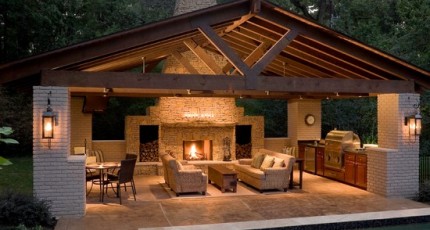Outdoor Dining Room

When we talk about adding an outdoor dining room to a Houston landscape, we are talking about adding something that is more than a room. What we end up creating is more of an outdoor environment dedicated to special occasions of specific moods and atmospheres.
This does not always involve creating enclosure in an obvious way. Often we only have to create a unique space whose prominent visibility draws the eye toward a point of interest. Something as simple as a chandelier hung from a tree that overhangs a table on a patio can be considered an outdoor dining room.
Rather than enclosing it with walls that rise up from the ground, we can continue the theme of illumination from above by encircling the pavilion with festoon lights.
This is only one example of how outdoor dining rooms can be used to transform Houston landscapes into realms of unique—yet still highly sophisticated—outdoor living experience. Outdoor dining rooms are always major destinations anywhere we build them. They can be either terminal points or focal points, depending on where they are located.
The most popular location to build an outdoor dining room is near an outdoor kitchen or just beyond the threshold of the house. There are many homeowners, however, who prefer to have them built either in the center of a large garden or at the end of a garden pathway as a sort of destination point along the backyard, nighttime landscape.
With few exceptions, the theme we work to create in almost all of these environments is a sense of relaxation and casual dining. We do little things like making sure that the dining room tables have adequate space between the chairs, and to design the room on an axel basis to give it a sense of balance and proportion from every possible vantage point within the room.
This way, no matter where one is seated, one experiences a sense of personal accommodation in the otherwise vast, expansive Houston landscape.
Instead of using rugs and carpet which the weather would easily damage, we decorate with stone mosaics that emulate the patterns seen on indoor rugs. If the room is designed between columns, these stones can also be placed between columns to create a feeling of grand entrance from either of two directions.
With the exception of occasional curtains and possibly an overhanging chandelier, too much formality is something that nine times out of ten the homeowners ask us to play down. That is not to say these structures are crude, but rather to say that sophistication is implied rather than overstated—especially when it comes to flooring. We want the flooring to work with the design without drawing too much attention to itself.
Any number simple materials can be used for this purpose. Gravel is a popular material anytime we build near a garden. Stone, brick, concrete, and wood are other commonly used materials, and all work very well for being either played up or played down so they never overpower the surrounding design or diminish the sense of being embedded in a comfortable, secretive spot on the Houston landscape set aside just for family and special friends.
The same principle applies to building walls around outdoor rooms. We always make it clear to our clients that walls in these environments are not to be confused with walls inside a home. Outdoor dining rooms need just enough enclosure to create a moment, but never so much as to ruin the view of the surrounding Houston landscape.
Walls are seldom as high as 5 feet in our designs, and if they are that high, tend to be made out of custom masonry that magnifies the sense of being outdoors rather than being trapped inside.
More often, we design more rudimentary, organic enclosures suing hedges that are low to the ground. Sometimes we do not even build a wall, but simply erect columns and hang curtains between them that create the sense of looking out of windows onto the surrounding Houston landscape.

